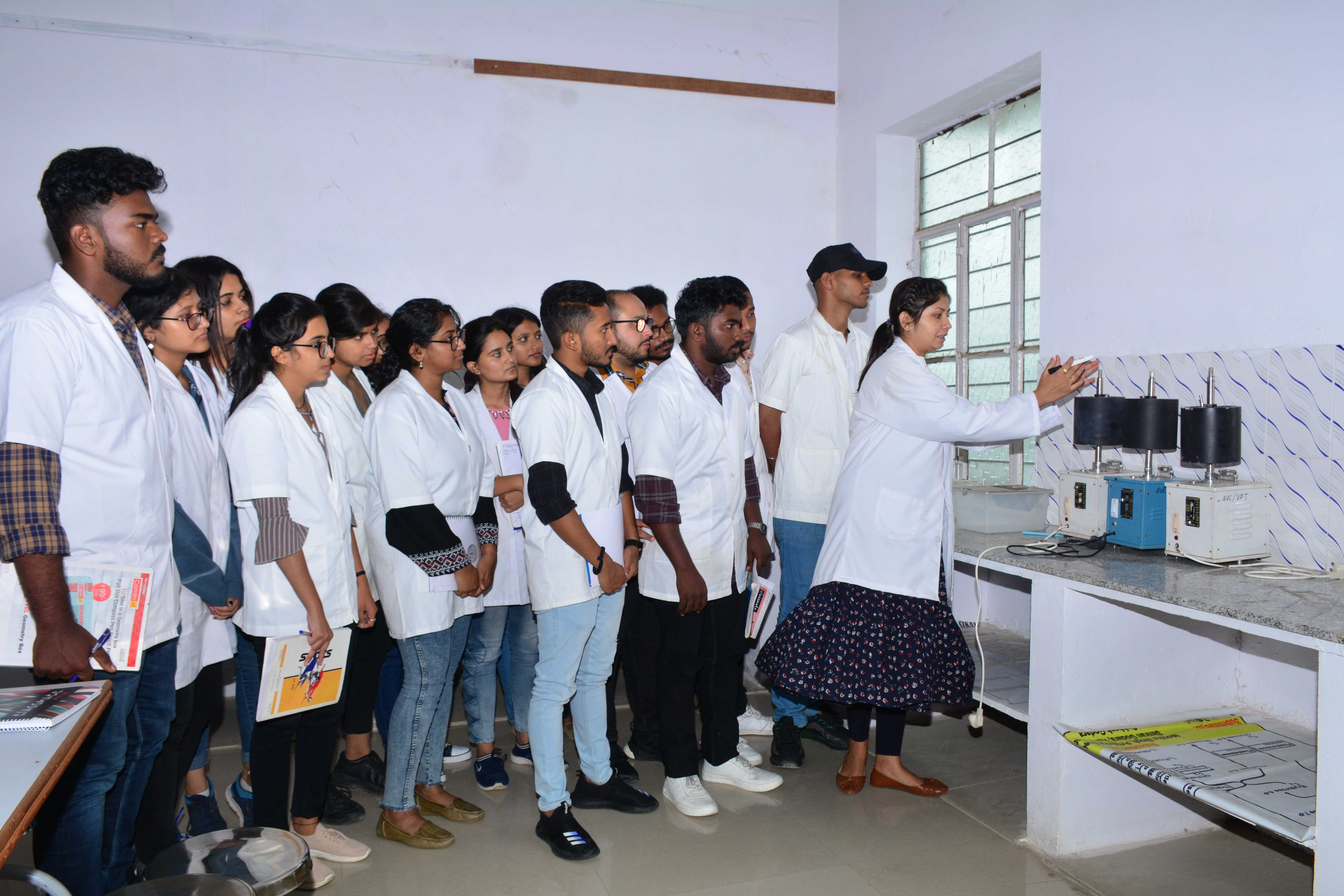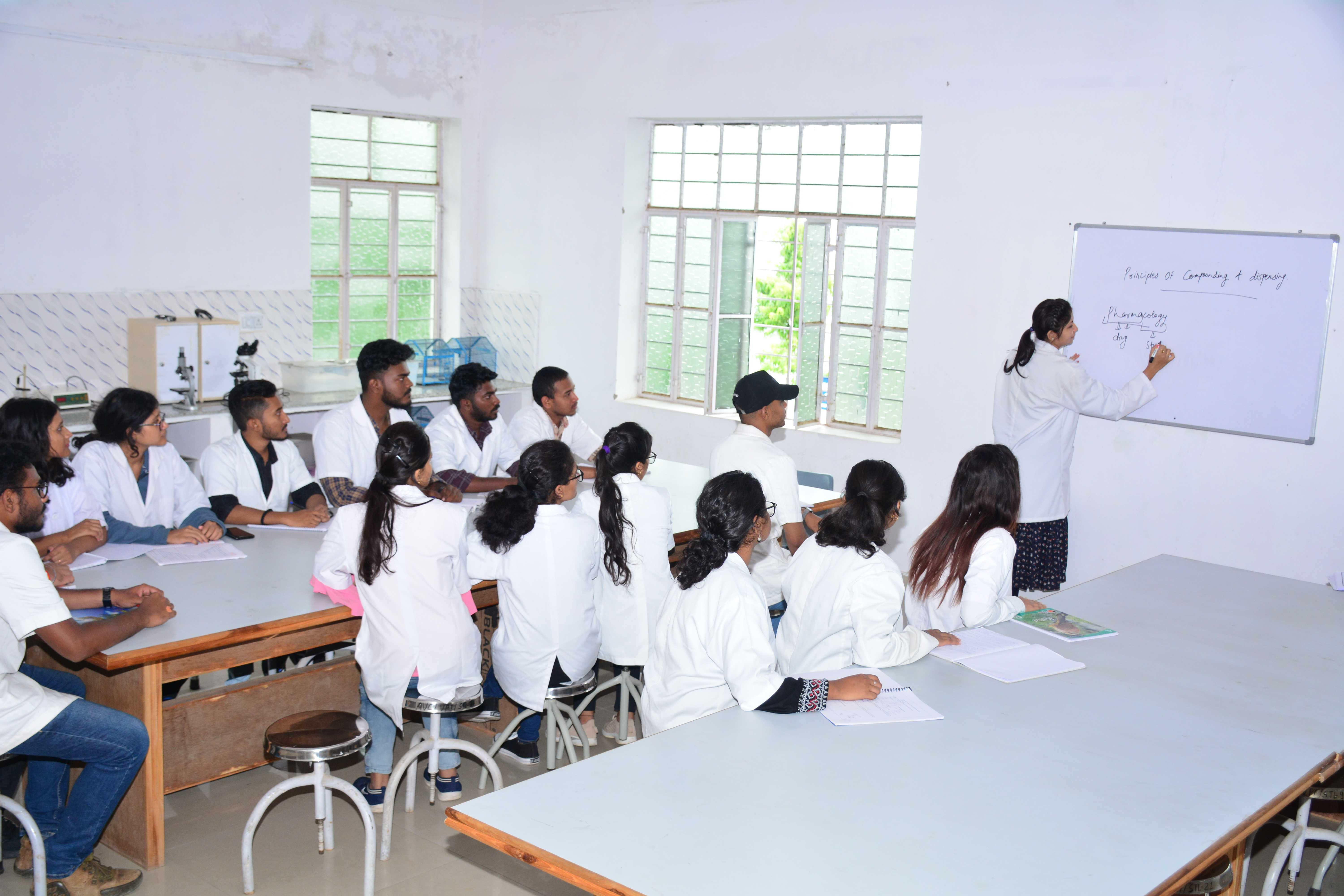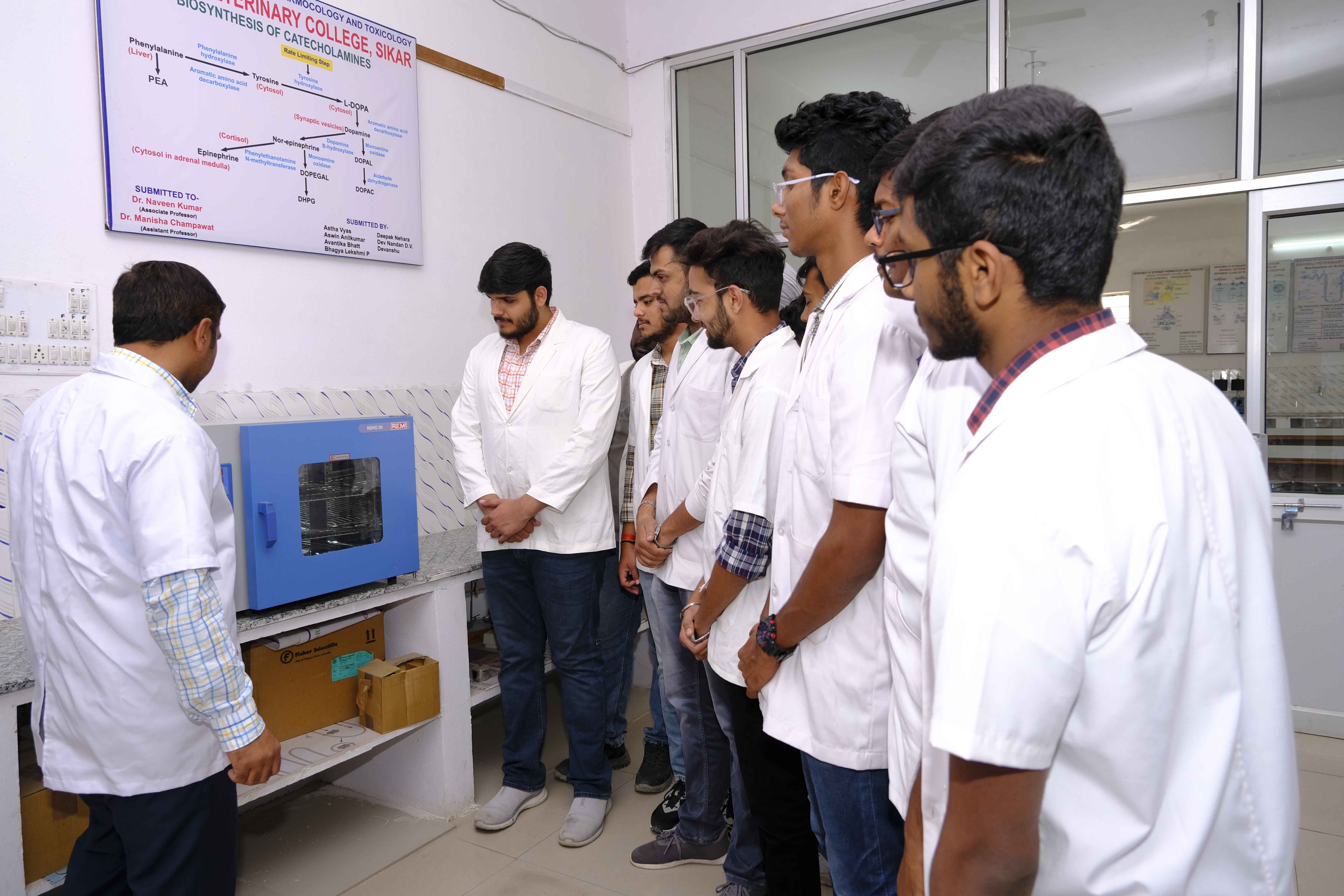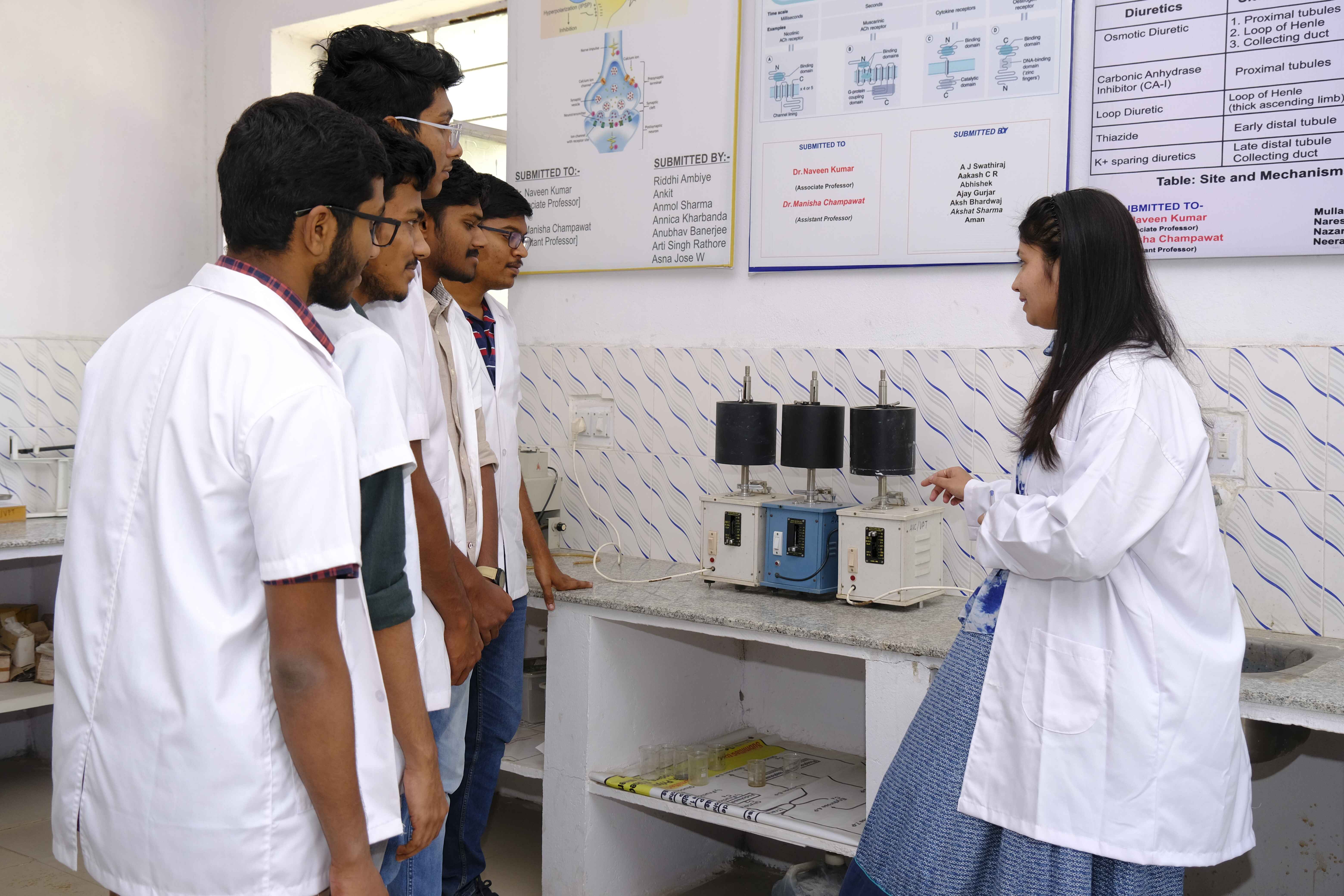



Department of Veterinary Pharmacology and Toxicology offers undergraduate courses to students in third professional year preparing for B.V.Sc.&A.H. degree. The courses of study envisage study of actions, mechanism of action and therapeutic and side or adverse effects of drugs in animals. Emphasis is given so that the students gain enough knowledge to select and prescribe a drug of choice for the treatment of an animal.
Students are given practice in pharmacy practical class to prepare some commonly used drug formulations. As per mandate of CPCSEA guidelines, practical classes in experimental pharmacology are conducted using software, simulation, video clips for demonstration of observation of effects of various classes of drugs in both intact laboratory animals and isolated organs/tissues as an alternate to use of animals.
The Department has following sanctioned strength of Faculty:
Professor - 1
Associate Professor – 1
Assistant Professors – 1
COURSES & SYLLABUS
S.No.
|
Name
|
Designation
|
Qualification
|
Service Period at AVC
|
Photo
|
Biodata |
|
01
|
Dr. R. D. Rana
|
Professor
|
B.V.Sc & AH, M.V.Sc and PhD
|
18.06.2021 to till Continue
|
|
|
|
02
|
Dr. Naveen Kumar
|
Associate Professor
|
B.V.Sc & AH, M.V.Sc and PhD
|
11.02.2021 to till Continue
|
 |
Biodata |
|
03
|
Dr. Harith CV
|
Assistant Professor
|
B.V.Sc & AH, M.V.Sc and PhD
|
30.12.2024 to till Continue
|
 |
Biodata |
|
04
|
Dr. Ravindra Pal Mandar
|
Assistant Professor
|
B.V.Sc & AH, M.V.Sc
|
02.05.2025 to till Continue
|
 |
Biodata |
THEORY
UNIT-1 (GENERAL PHARMACOLOGY)
Introduction, historical development, branches and scope of Pharmacology. Sources and nature of drugs. Pharmacological terms and definitions, nomenclature of drugs. Principles of drug activity: Pharmacokinetics - Routes of drug administration, absorption, distribution, biotransformation and excretion of drugs. Pharmacodynamics - Concept of drug and receptor, dose-response relationship, terms related to drug activity and factors modifying the drug effect and dosage. Adverse drug reactions, drug interactions.
UNIT-2 (DRUGS ACTING ON AUTONOMIC NERVOUS SYSTEM)
Neurohumoral transmission, Pharmacology of neurotransmitters. Adrenoceptors agonists and antagonists, adrenergic neuron blockers, cholinoceptor agonists and antagonists. Autacoids: Histamine, histamine analogues and antihistaminic agents, 5-Hydroxytryptamine and its agonists and antagonists, eicosanoids, platelet activating factors, angiotensin, bradykinin and kallidin.
UNIT-3 (DRUGS ACTING ON CENTRAL NERVOUS SYSTEM)
Classification of drugs acting on CNS. History, mechanism and stages of general anaesthesia. Inhalant, intravenous and dissociative anaesthetics. Hypnotics and sedatives; psychotropic drugs, anticonvulsants, opioid analgesics, non-steroidal anti-inflammatory drugs, analeptics and other CNS stimulants. Drugs acting on somaticnervous system: Local anaesthetics, muscle relaxants. Euthanizing agents.
UNIT-4 (DRUGS ACTING ON DIFFERENT BODY SYSTEMS)
Drugs acting on digestive system: Stomachics, antacids and antiulcers, prokinetics, carminatives, antizymotics, emetics ,antiemetics, purgatives, antidiarrhoeals, choleretics and cholagogues. Rumen pharmacology. Drugs acting on cardiovascular system: Cardiotonics and cardiac stimulants, antiarrhythmic drugs, vasodilators and antihypertensive agents, haematopoietic drugs, coagulants and anticoagulants, Drugs acting on respiratory system: Expectorants and antitussives, respiratory stimulants, bronchodilators and mucolytics. Drugs acting on urogenital system: Diuretics, drugs affecting urinary pH and tubular transport of drugs, ecbolics and tocolytics. Pharmacological basis of fluid therapy. Pharmacotherapeutics of hormones. Drugs acting on skin and mucous membranes: Emollients, demulcents and counter irritants
UNIT-5 (VETERINARY CHEMOTHERAPY)
Introduction and historical developments of chemotherapy. Antimicrobial agents: Classification, general principles inantimicrobial chemotherapy, antimicrobial resistance, combined antimicrobial therapy. Sulphonamides and theircombination with diaminopyrimidines. Penicillins, cephalopsorins, cephamycins and other beta lactams, beta lactamaseinhibitors. Aminoglycosides and aminocyclitols, tetracyclines, amphenicols (chloramphenicol, thiamphenicol, florfenicol), macrolides, quinolones and fluoroquinolones, polypeptides (polymixins, bacitracin) and glycopeptide antibiotics, miscellaneous agents: Lincosamides, novobiocin, virginiamycin, tiamulin, nitrofurans and methenamine, Antitubercular drugs. Antifungal agents: Topical and systemic agents including anti-fungal antibiotics. Antiviral and anticancer agents. Anthelmintics: Drugs used against nematodes, cestodes, trematodes. Antiprotozoal agents: Drugs usedin trypanosomosis, theileriosis, babesiosis, coccidiosis, amoebiosis, giardiosis and trichomoniasis. Ectoparasiticides, Antiseptics and disinfectants. Pharmacology of drugs of abuse in animals Pharmacology of indigenous medicinal plants: Scientific name, common name, active principles, pharmacological actions and therapeutic uses of Ginger, ocimum, neem, piper longum, withania, leptadenia, tinospora, embilica,eucalyptus, glycerrhiza, trichospermum, curcuma, adhantoda, butea, aloes, sena, rheubarb, catechu etc.
UNIT-6 (VETERINARY TOXICOLOGY)
General Toxicology: Definitions, history of toxicology, fundamentals and scope of toxicology. Sources and classification of toxicants, factors modifying toxicity, general approaches to diagnosis and treatment of poisoning. Toxicity caused by metals and non-metals: Arsenic, lead, mercury, copper, molybdenum, selenium, phosphorus, fluoride, nitrates or nitrites, chlorate, common salt and urea. Poisonous plants: Cyanogenetic plants, abrus, ipomoea, datura, nuxvomica, castor, oxalate producing plants, plants causing thiamine deficiency, plants causing photosensitization and lathyrism, oleander, and cotton. Toxicity caused by Agrochemicals: Insecticides - Chlorinated hydrocarbons, organophosphates, carbamates, pyrethroids, newer insecticides. Herbicides, fungicides and rodenticides. Fungal and bacterial toxins: Aflatoxins, rubratoxin, ochratoxin, sporidesmin, citrinin, F-2 toxin, trichothecenes, ergot, fescue, botulinum toxin and tetanus toxin Venomous bites and stings: Snake, scorpion, spider, bees and wasp, toad and fishes (puffer fish, shellfish). Toxicity caused by food additives and preservatives. Drug and pesticide residue toxicology. Environmental pollutants: Air and water pollutants. Concept of radiation hazards.
PRACTICAL
UNIT-1 (GENERAL PHARMACOLOGY)
Handling and washing of laboratory wares. Handling and operation of commonly used laboratory instruments. Concept of good laboratory practices (GLP). Pharmacy appliances. Principles of compounding and dispensing. Metrology, systems of weights and measures, pharmacy calculations. Pharmaceutical processes. Pharmaceutical dosage forms .Prescription writing, incompatibilities. Drug standards and regulations, custody of poisons. Compounding and dispensing of powders, ointments, mixtures, liniments, lotions, liquors, tinctures, emulsions, and electuaries.
UNIT-2 (ANS PHARMACOLOGY)
Demonstration of the action of autonomic agonists and antagonists on intact or isolated preparations of the laboratory animals. Simulated animal experiments should be preferred over use of live animals. The lab for simulated experiments should be established within a span of one year.
UNIT-3 (CNS PHARMACOLOGY)
Handling of lab animals. Regulatory guidelines for use of lab animals. Demonstration of the effect of CNS active drugs and local anaesthetics in laboratory animals. The lab for simulated experiments should be established within a span of one year.
UNIT-4 (VETERINARY CHEMOTHERAPY)
Demonstration of various chemotherapeutic agents and their dosage forms. Demonstration of antibiotic sensitivity test and its interpretation.
UNIT-5 (VETERINARY TOXICOLOGY)
Collection, preservation and dispatch of material for toxicological analysis. General principles for toxicological analysis. Detection of heavy metals or non-metals or plant poisons. Demonstration of agrochemical toxicity and its antidotal therapy via simulation methods. Demonstration of toxic weeds and plants of local area. Methods of calculation of median lethal dose (LD50) or maximum tolerated dose (MTD).
ANNUAL EXAMINATION
PAPERS U N I T S MAXIMUM MARKS WEIGHTAGE
THEORY
Paper-I 1, 2, 3 and 4 100 20
Paper-II 5 and 6 100 20
PRACTICAL
Paper-I 1 and 2 60 20
Paper - II 3, 4 and 5 60 20
INTERNAL ASSESSMENT. 20